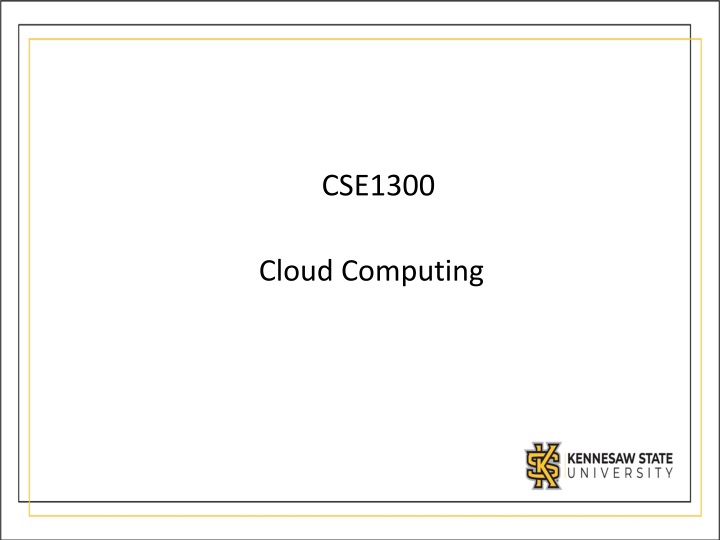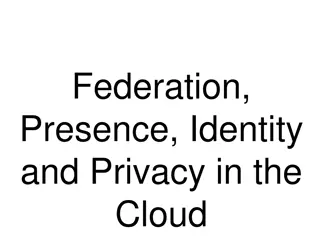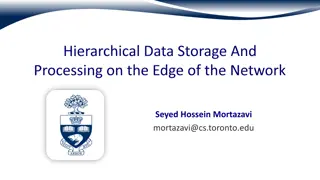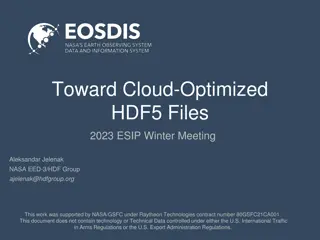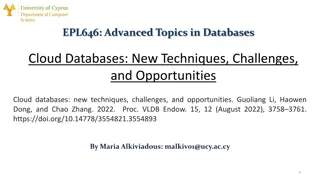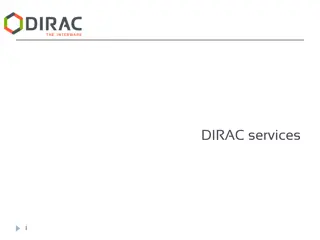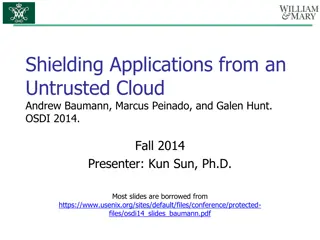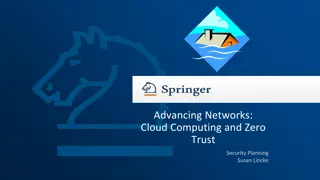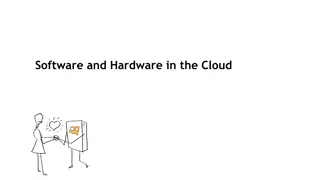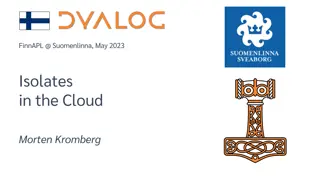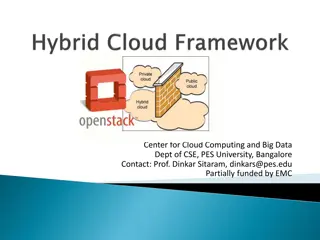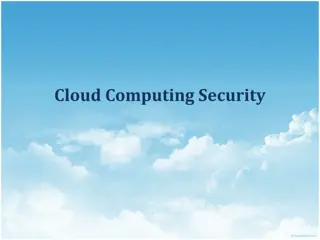Introduction to Cloud Computing
Cloud computing is the delivery of computing services over the Internet, providing access to servers, storage, databases, and more. This technology has a rich history, with benefits including cost efficiency, accessibility, scalability, automatic updates, and business continuity. Examples include web-based email services, office productivity software, and cloud storage solutions. Common cloud characteristics include on-demand self-service, broad network access, multi-tenancy, rapid elasticity, and measured service.
Uploaded on Mar 11, 2025 | 0 Views
Download Presentation

Please find below an Image/Link to download the presentation.
The content on the website is provided AS IS for your information and personal use only. It may not be sold, licensed, or shared on other websites without obtaining consent from the author.If you encounter any issues during the download, it is possible that the publisher has removed the file from their server.
You are allowed to download the files provided on this website for personal or commercial use, subject to the condition that they are used lawfully. All files are the property of their respective owners.
The content on the website is provided AS IS for your information and personal use only. It may not be sold, licensed, or shared on other websites without obtaining consent from the author.
E N D
Presentation Transcript
CSE1300 Cloud Computing
What is Cloud Computing? In Cloud Computing, the word cloud is used as a metaphor for "the Internet." In other words, we can say cloud is something, which is present at remote location. Well, it is an abstraction of underlying infrastructures involved. Simply put, cloud computing is the delivery of computing services - servers, storage, databases, networking, software, and analytics and more- over the Internet(Cloud). Cloud Computing consists of hardware and software resources made available on the internet as they are managed by the third-party services. These services typically provides access to advanced software applications, high end networks of server computers. "You don't generate your own electricity. Why generate your own computing?" -Jeff Bezos, Amazon
History It was a gradual evolution that started in the 1950s with mainframe computing In 1972 IBM created the first virtual machine. In 1999, Salesforce.com started delivering of applications to users using a simple website. In 2002 Amazon provided First public cloud AWS (Amazon Web Service) , providing services like storage, computation. In 2009, Google Apps also started to provide cloud computing enterprise applications. In 2009, Microsoft launched Windows Azure, and companies like Oracle and HP have all joined the game. This proves that today, cloud computing has become mainstream
Benefits of cloud computing Drive down costs Accessibility Productivity Scalability Access to automatic updates Business Continuity (Back up & Recovery) Pay structure
Simple Examples of cloud computing Email: Web-based email services like Gmail and Hotmail deliver a cloud computing service: users can access their email "in the cloud" from any computer with a browser and Internet connection, regardless of what kind of hardware is on that particular computer. The emails are hosted on Google's and Microsoft's servers, rather than being stored locally on the client computer. Office Productivity Software: Office 365, Google docs and Zoho office. This software allow you to keep and edit your documents online. By doing so, the documents will be accessible anywhere, and you can share the documents and collaborate on them. Multiple people can work in the same document simultaneously. Storage: One Drive, Google Drive, iCloud and Drop Box
Common Cloud Characteristics On Demand Self Service Broad network access Multi-Tenancy (Resource Pooling) Rapid Elasticity Measured service
Cloud Models Deployment Models - A cloud deployment model represents a specific type of cloud environment, primarily distinguished by ownership, size, and access. There are three common cloud deployment models Hybrid, Private and Public clouds Service Models - In the world of cloud computing, there are three different approaches to cloud-based services: Infrastructure as a Service (laaS) Platform as a Service (PaaS) Software as a Service (SaaS
Deployment Models Public Cloud: Public clouds are owned and operated by a third-party cloud service provider, which deliver their computing resources like servers and storage over the internet. As the name suggests, Public cloud is open to public. Anyone can access and use it by paying accordingly Private Cloud: The private cloud, in contrast to its public counterpart, isn't available to the public but is built specifically for a single organization to fit its needs. It may be managed internally or by a third- party and be hosted internally or externally. Hybrid Cloud: A hybrid cloud is a combination of a private cloud combined with the use of public cloud services allowing data and applications to move between private and public clouds. This model gives business greater flexibility and more deployment option
Service Models Infrastructure as a service (laaS):is a cloud computing offering in which a vendor provides users access to computing resources such as servers, storage, and networking. Organizations use their own platforms and applications within a service provider's infrastructure. Key features: Instead of purchasing hardware outright, users pay for laas on demand. Infrastructure is scalable depending on processing and storage needs. Saves enterprises the costs of buying and maintaining their own hardware. Because data is on the cloud, there is no single point of failure
Service Models Platform as a service (PaaS): is a cloud computing offering that provides users a cloud environment in which they can develop, manage, and deliver applications. In addition to storage and other computing resources, users are able to use a suite of prebuilt tools to develop, customize and test their own applications. Key features Paas provides a platform with tools to test, develop, and host applications in the same environment. Enables organizations to focus on development without having to worry about underlying infrastructure. Providers manage security, operating systems, server software, and backups. Facilitates collaborative work even if teams work remotely
Service Models Software as a service (SaaS): is a cloud computing offering that provides users with access to a vendor's cloud-based software. Users do not install applications on their local devices. Instead, the applications reside on a remote cloud network accessed through the web or an API. Through the application, users can store and analyze data and collaborate on projects. Key features: SaaS vendors provide users with software and applications on a subscription model. Users do not have to manage, install, or upgrade software; SaaS providers manage this. Data is secure in the cloud; equipment failure does not result in loss of data. Use of resources can be scaled depending on service needs
Pros and Cons of cloud computing Pros: Cons: Reduced hardware equipment for end-users Improved performance Lower H/W and S/W maintenance Instant software updates Accessibility Metered services Less expensive Improved Disaster Recovery Requires good internet speed with good bandwidth Security Limited control on Infrastructure
What is Microsoft Azure? Azure is a flexible cloud platform (PaaS) that enables you to quickly build, deploy and manage applications across a global network of Microsoft - managed datacenters. You can build applications using any language, tool or framework Virtual Machines: Azure gives you the ability to create VMs by simply specifying the size and virtual hard disks (VHD) you want to use. Azure provides access to both Windows and Linux VHDs, so the developers has a freedom to choose what they want to work. Developers can use VMs to build and test applications quickly at low cost. Web Sites: You can use Azure as a platform for creating and hosting websites and web application
Microsoft Azure Mobile Services: Azure's Mobile services give you the tools to create and deploy applications. The information that gets accessed by the app running on your device is stored in what's called a back-end database, and so Mobile services are reffered to as mobile Back-end as a service (mBaaS). With Azure, you can build apps for Android, iOS, HTML / JavaScript and Windows Phone. Azure supports the broadest selection of operating systems, programming languages, frameworks, tools, databases and devices. Build apps with JavaScript, Python, NET, PHP, Java and Node.js; build back-ends for iOs, Android and Windows devices. Azure cloud service supports the same technologies millions of developers and IT professionals already rely on and trust.
Amazon Web Services (AWS) Amazon Web Services is a leading cloud computing platform that provides on-demand compute, storage, networking, and more. Utility Model: Offers pay-as-you-go pricing, enabling organizations to pay only for resources they use. Market Leader: Widely adopted by startups, enterprises, and government organizations due to its breadth of services.
Amazon Web Services (AWS) Scalability: Quickly scale up or down to handle varying workloads without large upfront hardware investments. Global Infrastructure: Data centers across multiple geographic regions, improving performance and redundancy. Range of Services: Compute (Amazon EC2, AWS Lambda), Storage (Amazon S3, Amazon EBS), Databases (Amazon RDS, DynamoDB), Analytics, AI/ML, and more. Cost Efficiency: Pay-per-use model, reserved instances, and spot instances reduce total cost of ownership.
AWS Security Considerations Shared Responsibility Model: AWS handles physical security and infrastructure; customers secure their apps and data configurations. Compliance: Provides numerous certifications (ISO 27001, PCI DSS, HIPAA, SOC 2) to meet regulatory requirements. Data Protection: Options for encryption at rest (KMS) and in transit (TLS/SSL). Identity & Access Management: Fine-grained access control with AWS IAM for users, groups, roles, and policies. Logging & Monitoring: Tools like Amazon CloudWatch, AWS CloudTrail, and AWS Config for real-time insights and auditing.
AWS Amazon Web Services (AWS) provides a robust, flexible, and secure cloud ecosystem, similar in concept to other major cloud providers. Its wide array of services, global presence, and pay-as- you-go model help businesses accelerate innovation and reduce operational overhead. While AWS offers strong security features and compliance certifications, due diligence in configuration and ongoing management remains vital to protect sensitive data and resources.
Other large cloud providers Google Cloud Platform (GCP): Offers mostly the same capabilities as Azure and AWS. Offers Kubernetes natively. Offers GPU rental for rendering, AI Oracle Cloud: Mostly focuses on databases but offers other services also Rackspace Red Hat IBM Etc.
Conclusion Cloud computing has quickly become one of the most prominent buzzwords in the IT world due to its revolutionary model of computing as a utility. It promises increased flexibility, scalability, and reliability, while promising decreased operational and support costs Despite the potential gains achieved from the cloud computing, the organizations are slow in accepting it due to security issues and challenges associated with it. Security is one of the major issues which hamper the growth of cloud. The idea of handing over important data to another company is worrisome; such that the consumers need to be vigilant in understanding the risks of data breaches in this new environment.
